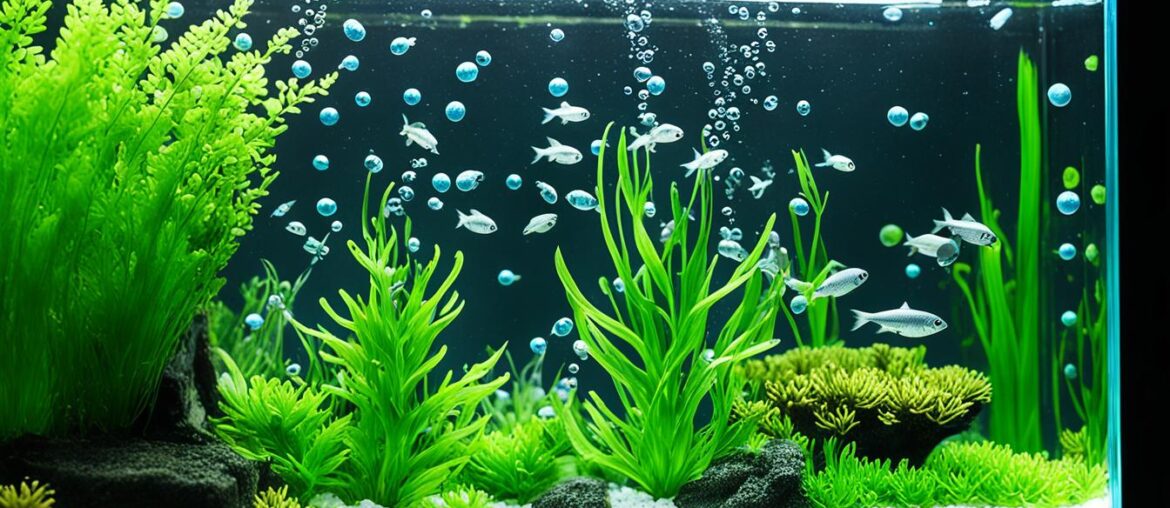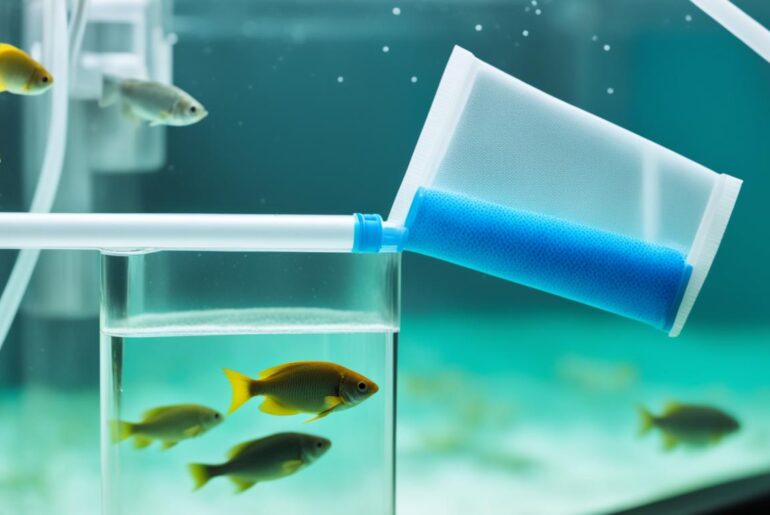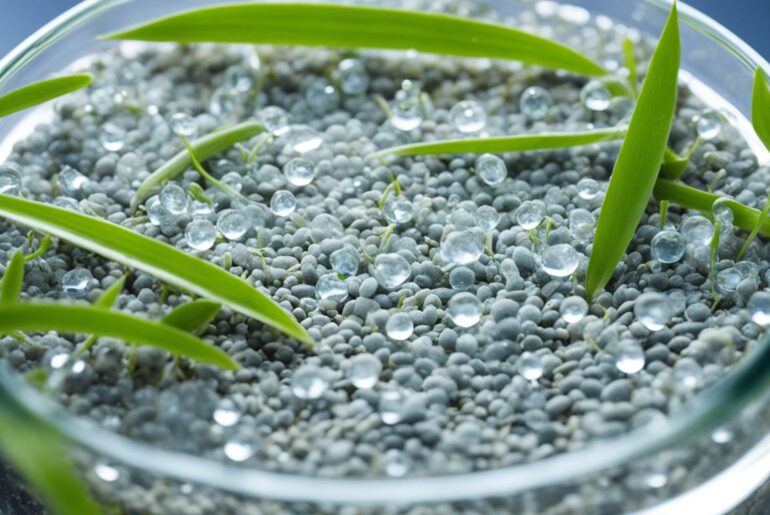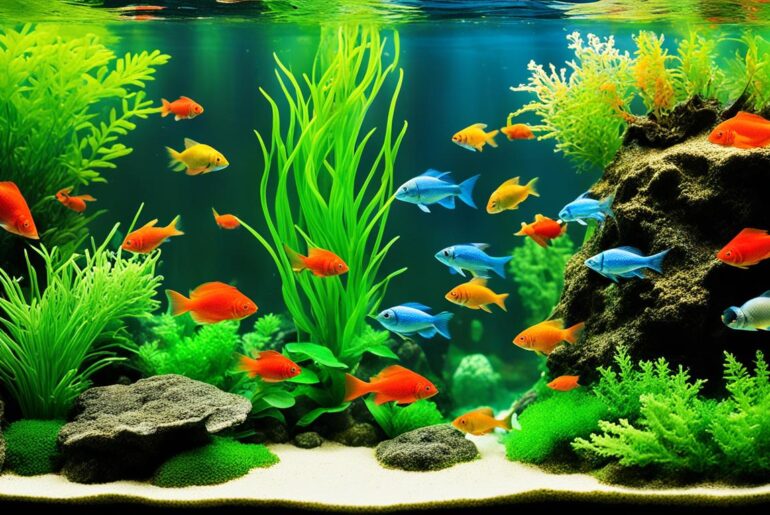When I first started my journey as an aquarium enthusiast, I was filled with excitement and anticipation. I carefully set up my new tank, researching the best substrate, decor, and fish for my aquatic paradise. But little did I know that my excitement would soon turn into despair when I encountered a nitrite spike in my new aquarium cycle.
It was heartbreaking to witness the effects of high nitrite levels on my beloved fish. Despite my efforts to maintain a clean and healthy environment, the toxic nitrites had taken their toll. I felt a deep sense of responsibility and guilt for not fully understanding the intricacies of the aquarium nitrogen cycle and how to control nitrite spikes.
But through this difficult experience, I became determined to educate myself and find effective solutions to prevent future nitrite spikes in my fish tank. I immersed myself in learning about the nitrogen cycle, discovering the crucial role bacteria play in converting ammonia into nitrites, and the importance of keeping nitrite levels at zero for the well-being of my fish.
Now, armed with knowledge and a deep empathy for fellow aquarium enthusiasts who may be facing the same challenges, I want to share with you a comprehensive guide on managing nitrite spikes in your new aquarium cycle. Let’s dive in and explore practical strategies to control and reduce nitrite levels, ensuring a safe and thriving environment for our aquatic companions.
Key Takeaways:
- Understanding the aquarium nitrogen cycle is crucial for managing nitrite spikes in new tank setups.
- High nitrite levels can be toxic to fish and lead to nitrite poisoning, causing suffocation and stress.
- Common causes of high nitrite levels include overfeeding, waste buildup, weak filtration, and overstocking.
- Testing nitrite levels using reliable test kits is essential for monitoring and taking appropriate action.
- Reducing nitrite levels can be achieved through water changes, the addition of cycled filters, and the use of water conditioners.
What Are Aquarium Nitrites and Where Do They Come From?
Aquarium nitrites, pronounced nigh-trights, are a form of dissolved nitrogen that occur naturally in the water column of an aquarium. They are produced from waste sources such as uneaten fish food, fish poop, decaying plants, and dirty filters. The nitrogen cycle is the process by which waste is broken down into ammonia, which is then converted into nitrites by bacteria called nitrosomonas. Nitrites would not exist without the presence of ammonia in the tank. The process of converting ammonia into nitrites by bacteria is known as nitrification.
Sources of Nitrites in Aquarium
In an aquarium, nitrites are primarily sourced from the waste produced within the tank. This waste includes uneaten fish food, fish waste (poop), decaying plants, and dirty filters. As these waste substances break down, they release ammonia into the water.
Ammonia is then converted into nitrites through the nitrification process. This process is carried out by specific bacteria called nitrosomonas, which are present in the tank. The bacteria consume ammonia, turning it into nitrites as part of their metabolic activity.
Therefore, the main sources of nitrites in an aquarium are the waste materials and the bacteria responsible for the nitrification process.
The Role of Waste in Nitrite Production
Waste in an aquarium plays a crucial role in the production of nitrites. As fish consume food and produce waste, organic compounds are released into the water. These organic compounds contain nitrogen, which is eventually transformed into nitrites.
The breakdown of waste materials by bacteria initiates the nitrogen cycle. The waste substances provide the necessary nitrogen source for the production of nitrites. Bacteria convert the initial ammonia into nitrites, creating a suitable environment for the next stage of the nitrogen cycle.
The Nitrogen Cycle and the Nitrification Process
The nitrogen cycle in an aquarium is a natural biological process that converts various nitrogen compounds. It involves the transformation of ammonia into nitrites and further into nitrates, ultimately aiding in the removal of toxins from the water.
The nitrification process is an essential part of the nitrogen cycle. It consists of two key steps:
- Nitrosomonas bacteria convert ammonia into nitrites: Nitrosomonas bacteria, which are present in the tank, utilize ammonia as their energy source. As they metabolize the ammonia, they produce nitrites as a byproduct. This conversion releases energy for the bacteria to survive and multiply.
- Nitrobacter bacteria convert nitrites into nitrates: Once the nitrites are produced, another group of bacteria called Nitrobacter take over. These bacteria convert nitrites into less toxic nitrates, which can be safely utilized by aquatic plants or removed through water changes.
The nitrogen cycle and the nitrification process work together to continually break down and remove harmful nitrogen compounds in the aquarium, maintaining water quality and the overall health of the aquatic ecosystem.
What Nitrite Levels Are Acceptable in Your Aquarium?
In order to maintain a healthy and thriving aquarium, it is essential to monitor and control nitrite levels. Nitrites, although naturally occurring, can be harmful to fish if present in high concentrations. The acceptable level of nitrites in a stocked tank should be zero parts per million (ppm). In an established tank, the bacteria responsible for breaking down nitrites should be present in sufficient numbers to convert them to less harmful substances, resulting in a zero reading when tested.
However, during the cycling of a new tank, it is normal to experience high levels of nitrites. This is because the beneficial bacteria that break down nitrites are not yet established in large numbers. These high nitrite levels during new tank cycling can be harmful to fish and can cause stress and even suffocation. Therefore, it is crucial to closely monitor nitrite levels and take appropriate action if levels exceed zero.
Factors Affecting Nitrite Levels in Aquariums
There are several factors that can influence nitrite levels in aquariums:
- New tank cycling: During the initial stages of setting up a new tank, nitrite levels will naturally be high as the beneficial bacteria responsible for converting nitrites are still establishing themselves.
- Overfeeding: Excessive feeding can lead to increased waste production, which in turn can result in elevated nitrite levels.
- Poor filtration: Inadequate or weak filtration can prevent the removal of nitrites from the water, allowing them to accumulate to dangerous levels.
- Overstocking: Having too many fish in the aquarium can overload the biological filtration capacity, leading to a buildup of nitrites.
By understanding these factors and taking appropriate measures to address them, fishkeepers can maintain acceptable nitrite levels in their aquariums, ensuring the health and well-being of their aquatic pets.

What Happens If Your Aquarium Nitrite Levels Are Too High?
When nitrite levels exceed zero in an aquarium, fish absorb them into their bloodstream. Nitrites inhibit the blood’s ability to carry oxygen, leading to suffocation. Even in oxygenated aquariums, fish can still suffocate if they cannot draw oxygen from the water due to high nitrite levels. This condition is known as nitrite poisoning. The toxicity of nitrites varies among different fish species, with some being more tolerant than others. However, even if fish can tolerate high nitrite levels, it can still cause stress, which can lead to various health issues such as diseases, loss of color, stunted growth, and reproductive issues. It is important to keep nitrite levels at zero to ensure the well-being of fish.
The Effects of Nitrite Poisoning in Fish
Nitrite poisoning in fish leads to oxygen deprivation as nitrites hinder the ability of the blood to carry oxygen. This can result in suffocation even in well-oxygenated aquariums. The inability to draw sufficient oxygen from the water can be fatal and cause significant distress to fish. Nitrite toxicity varies among fish species, with some being more sensitive than others. Even fish species that can tolerate high nitrite levels can still experience stress, leading to other health issues and compromising their overall well-being.
“High nitrite levels can quickly lead to fish suffocating in their own environment. It is crucial to monitor nitrite levels regularly and take immediate action to maintain a safe and healthy aquarium for your fish.” – Marine Biology & Aquatic Research
Signs of Nitrite Poisoning in Fish
Recognizing the signs of nitrite poisoning in fish is vital for early intervention and treating the issue. Common symptoms include:
- Rapid and labored breathing
- Lethargy and reduced activity
- Gasping at the water surface
- Loss of appetite
- Color changes, such as paleness or darkening
- Red or inflamed gills
Preventing Fish Stress from High Nitrite Levels
To prevent fish stress caused by high nitrite levels, it is crucial to maintain optimal water quality in your aquarium. Regularly test nitrite levels and take immediate action if they exceed zero. Steps to prevent fish stress include:
- Performing regular water changes to dilute nitrite levels
- Adding cycled filters from an established tank to introduce beneficial bacteria that consume nitrites
- Using water conditioners, such as Seachem Prime, to bind nitrites and render them harmless
- Maintaining proper aquarium filtration and preventing waste buildup
- Ensuring appropriate fish stocking levels to minimize waste production
| Fish Species | Tolerance to Nitrites |
|---|---|
| Goldfish | High |
| Betta Fish | Moderate |
| Tetras | Low |
What Causes High Nitrite Levels in Aquariums?
When it comes to managing the health and well-being of your fish, controlling nitrite levels in your aquarium is crucial. High nitrite levels can be harmful and even deadly to fish, causing stress, suffocation, and nitrite poisoning. To keep your fish happy and healthy, it’s essential to understand the causes of high nitrite levels in aquariums and take appropriate measures to prevent them.
1. Overfeeding in Aquarium:
Overfeeding is a common mistake that many aquarium enthusiasts make. When excessive amounts of fish food are added to the tank, the uneaten food quickly decays, leading to a buildup of waste. This waste acts as a food source for bacteria, resulting in the production of nitrites. To avoid overfeeding, it’s important to feed your fish the appropriate amount of food and remove any uneaten food promptly.
2. Waste Buildup in Aquarium:
Waste buildup can occur due to various reasons, such as inadequate cleaning and maintenance practices. When waste accumulates in the aquarium, it decomposes and releases ammonia, which is then converted into nitrites by nitrifying bacteria. Regular cleaning and maintenance, including vacuuming the substrate and removing debris, can help prevent waste buildup and subsequent nitrite production.
3. Lack of Bacteria in Filter:
The filtration system in your aquarium plays a crucial role in maintaining water quality. Nitrifying bacteria, specifically nitrosomonas, are responsible for breaking down ammonia into nitrites. If your filter lacks sufficient colonies of these beneficial bacteria, the ammonia will not be effectively converted, leading to elevated nitrite levels. It’s important to establish and maintain a healthy population of nitrifying bacteria to ensure proper ammonia and nitrite conversion.
4. Weak Filtration:
A weak filtration system may not adequately remove nitrites from the water, allowing them to accumulate in higher concentrations. It’s essential to choose a filtration system that is appropriately sized for your aquarium and can effectively remove both physical and chemical impurities, including nitrites. Regular filter maintenance, such as cleaning or replacing filter media, is also important in ensuring optimal filtration efficiency.
5. Overstocking:
Overstocking your aquarium can lead to an excess bio load, resulting in increased waste production. The more fish and other aquatic creatures in your tank, the more waste they produce, including ammonia that eventually converts into nitrites. Maintaining a proper stocking level and ensuring adequate space and resources for each fish are essential to prevent high nitrite levels.
By understanding and addressing the causes of high nitrite levels in your aquarium, you can create and maintain a healthy environment for your fish. Regular testing, monitoring, and appropriate actions, such as proper feeding, regular maintenance, and maintaining a balanced fish population, will help keep nitrite levels in check.
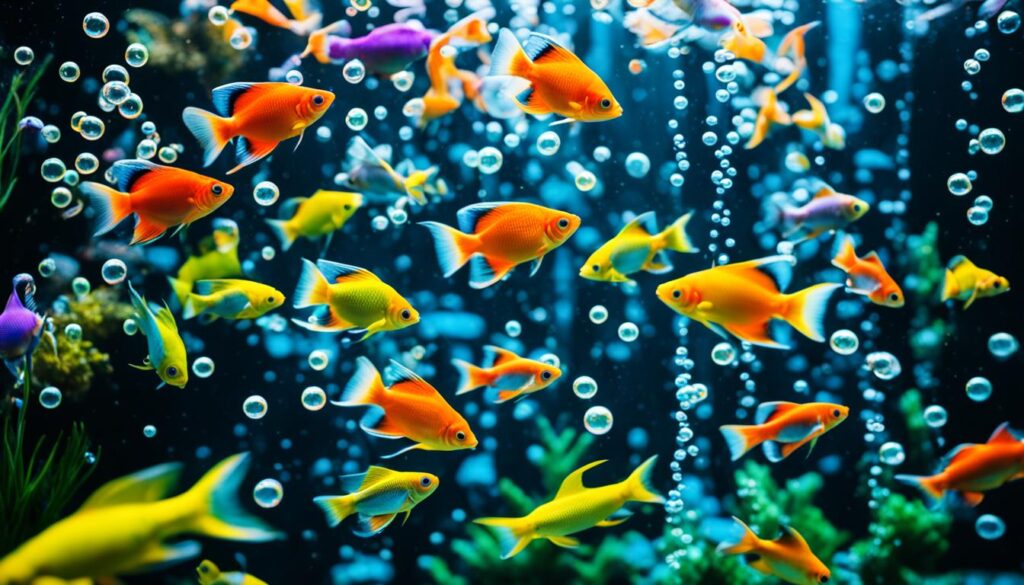
How Do You Test for Nitrites?
Nitrite testing is a crucial step in maintaining a healthy aquarium environment. By regularly monitoring nitrite levels, fish owners can ensure the well-being and longevity of their aquatic pets. There are several methods available for testing nitrites, ranging from basic test kits to more advanced colorimeters. Let’s explore these options in detail:
1. Nitrite Test Kits
Nitrite test kits are widely available and offer a simple and cost-effective solution for measuring nitrite levels in your aquarium. Two popular options are the API Nitrite Test Kit and the Salifert Nitrite NO3 Test Kit. These kits typically include testing reagents, a color chart, and detailed instructions for accurate readings. However, it’s important to note that certain test kits, like the API Nitrite Test Kit, may show lower nitrite levels due to amine interference, which can be a concern in reef tanks.
2. Hanna Nitrite Colorimeter
If you’re looking for more precise and accurate nitrite testing, consider using the Hanna Nitrite Colorimeter. This handheld device offers digital readouts of nitrite levels, eliminating the need for subjective color matching. The Hanna Nitrite Colorimeter provides reliable and consistent results, making it a popular choice among serious aquarium enthusiasts and professionals.
Regardless of the method you choose, it’s crucial to read and follow the instructions provided with the test kits or colorimeter. Proper testing techniques and adherence to recommended procedures will ensure the accuracy of your nitrite readings.
Testing your aquarium for nitrites should be a routine part of your maintenance regimen. By regularly monitoring these levels, you can promptly detect any deviations and take appropriate measures to maintain a safe and healthy environment for your fish.

| Method | Pros | Cons |
|---|---|---|
| Nitrite Test Kits | Simple and cost-effective | Some kits may show lower nitrite levels due to amine interference |
| Hanna Nitrite Colorimeter | Precise and accurate | Higher initial investment |
How Do You Reduce Nitrite Levels?
If nitrite levels in your aquarium are elevated, immediate actions can be taken to reduce them. Here are some effective strategies:
1. Water Changes for Nitrite Reduction
A 30-50% water change is recommended to dilute the nitrites in your aquarium. By replacing a significant portion of the water, you can lower the concentration of nitrites and help create a healthier environment for your fish.
2. Adding Cycled Filters
Introducing cycled filters from an established tank can help lower elevated nitrite levels. These filters contain beneficial bacteria that are responsible for breaking down nitrites into safer compounds. By adding these filters, you introduce a colony of bacteria that can actively consume nitrites, further reducing their concentration in the water.
3. Water Conditioners for Nitrite Removal
Water conditioners such as Seachem Prime can be effective in reducing nitrite levels. Seachem Prime not only binds with nitrites, rendering them harmless to fish, but it also provides an opportunity for the filter bacteria to break down the nitrites into nitrates—a less harmful form of nitrogen. Seachem Prime is a popular choice among aquarium enthusiasts for its ability to detoxify nitrites and address various water quality issues.
Remember to follow the instructions provided with the water conditioner and dosage recommendations to ensure safe and effective nitrite removal.
“Water changes, adding cycled filters, and using water conditioners are immediate measures that can help reduce elevated nitrite levels in your aquarium.”
Implementing these techniques can help restore and maintain optimal nitrite levels in your aquarium, ensuring a healthier and safer environment for your fish. Regular testing using nitrite test kits and consistent monitoring are key to preventing nitrite-related issues and maintaining the well-being of your aquatic pets.
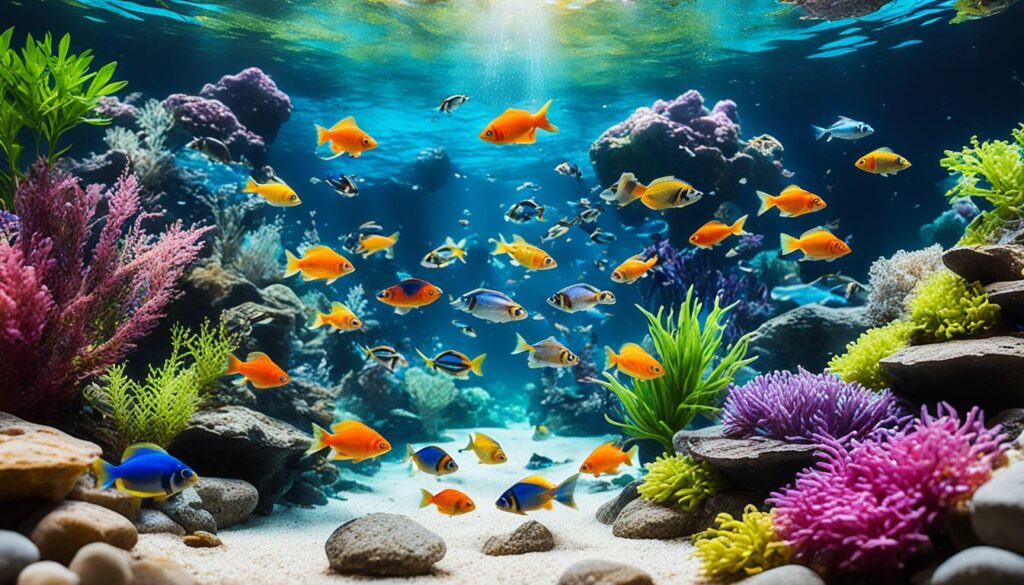
| Nitrite Reduction Strategies | Benefits |
|---|---|
| Water Changes | – Dilutes nitrites in the water – Helps maintain a healthy environment |
| Adding Cycled Filters | – Introduces beneficial bacteria that consume nitrites – Reduces nitrite concentration |
| Water Conditioners | – Binds with nitrites, rendering them harmless – Supports the breakdown of nitrites into nitrates |
Long-Term Solutions for Maintaining Undetectable Nitrite Levels
To ensure the long-term maintenance of undetectable nitrite levels in your aquarium, it is important to implement certain strategies that promote a healthy and balanced environment for your fish. By focusing on proper aquarium filtration, regular maintenance, the benefits of live plants, and responsible fish population management, you can effectively control nitrite levels and create a thriving aquatic ecosystem.
Proper Aquarium Filtration: Biological, Mechanical, and Chemical
One of the most crucial aspects of maintaining undetectable nitrite levels is having a comprehensive filtration system in your aquarium. This includes biological, mechanical, and chemical filtration methods to remove nitrites and other pollutants from the water.
Biological filtration is essential as it relies on beneficial bacteria that break down nitrites and convert them into less harmful nitrates. These bacteria colonize in the filter media, substrate, and other surfaces within the aquarium.
Mechanical filtration helps trap solid waste particles and debris, preventing them from breaking down and contributing to the buildup of nitrites. Regularly cleaning the mechanical filter components, such as sponges or filter pads, ensures their effectiveness in removing pollutants.
Chemical filtration involves the use of activated carbon or other chemical filter media to absorb and remove impurities, including nitrites, from the water. This type of filtration can be particularly helpful in controlling nitrite levels.
Regular Aquarium Maintenance
Maintaining a regular maintenance routine is essential for nitrite control in your aquarium. Performing regular water changes helps dilute nitrite concentrations and remove accumulated nitrates and other pollutants. Aim to change 10-20% of the water volume every 1-2 weeks, or as necessary based on nitrite test results.
In addition to water changes, cleaning the aquarium filters at regular intervals is critical. This ensures that the filters function optimally, removing nitrite-producing waste and promoting the growth of beneficial bacteria.
Proper waste management is also crucial in preventing nitrite buildup. Remove uneaten food, decaying plant matter, and other organic waste from the aquarium to minimize the potential for nitrite production.
The Benefits of Live Plants
Incorporating live plants into your aquarium not only enhances its aesthetic appeal but also helps control nitrite levels. Live plants absorb nitrates as a nutrient source for growth, reducing nitrite concentrations in the water. The root systems of plants also provide habitat for beneficial bacteria, further aiding in nitrite breakdown.
Popular aquarium plants that are known for their nitrate-absorbing properties include Anubias, Java Fern, Amazon Sword, and Hornwort. These plants are relatively easy to care for and can contribute to maintaining undetectable nitrite levels.
Fish Population Management
Responsible fish population management is essential for maintaining a healthy balance in your aquarium and controlling nitrite levels. Avoid overstocking the tank, as excess fish waste can contribute to elevated nitrite levels. Calculate the appropriate number and size of fish based on the tank’s filtration capacity, ensuring that the biological load does not exceed the system’s capabilities.
Additionally, be mindful of the compatibility of fish species in terms of their waste production and feeding habits. Some species produce more waste than others, and their combination can lead to increased nitrite levels. Research your fish species and their specific requirements to make informed decisions about their compatibility in your aquarium.
By implementing these long-term solutions for maintaining undetectable nitrite levels, you can create a healthy and thriving environment for your fish. Proper filtration, regular maintenance, the use of live plants, and responsible fish population management are key factors in achieving optimal nitrite control.
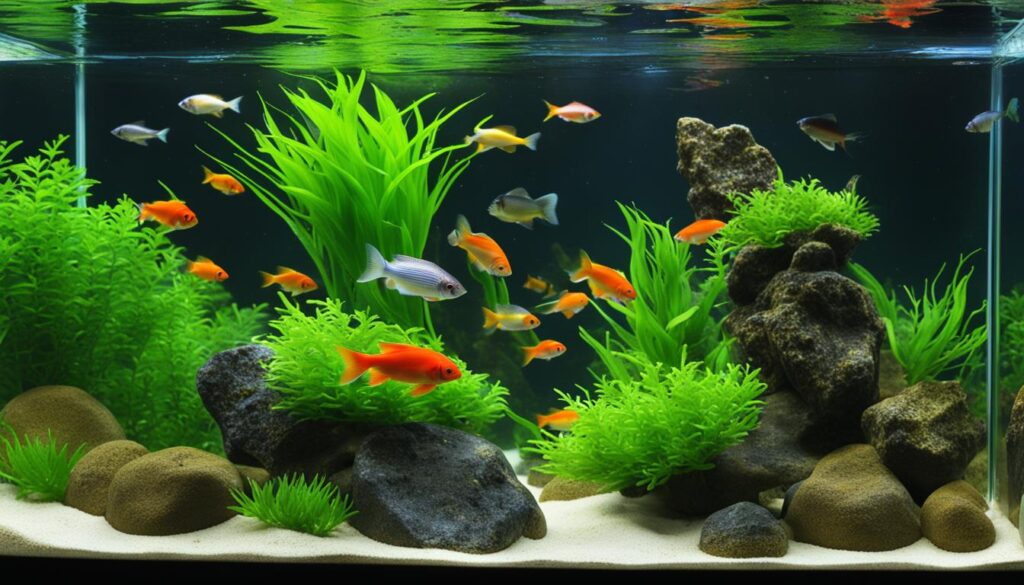
Conclusion
Managing the nitrite spike in the new aquarium cycle is crucial for creating a healthy and safe environment for your fish. Although nitrites are naturally occurring, high levels can be harmful to fish. Therefore, it is essential to regularly test and monitor nitrite levels using nitrite test kits. By doing so, you can take immediate actions to control elevated nitrite levels.
Water changes and the addition of cycled filters are effective techniques to reduce nitrite levels in the short term. However, to maintain undetectable nitrite levels in the long term, it is important to implement proper aquarium filtration, regularly maintain your aquarium, and consider the use of live plants. These long-term solutions will help create a balanced ecosystem and ensure the well-being of your aquatic pets.
In conclusion, by managing nitrite spikes, controlling nitrite levels, and creating a healthy fish environment, you can provide the best possible living conditions for your fish. Remember to regularly test nitrite levels, take immediate actions when levels are elevated, and maintain a long-term plan to ensure undetectable nitrite levels in your aquarium. By following these techniques, you can enjoy a vibrant and thriving aquatic ecosystem in your home.
FAQ
What are aquarium nitrites and where do they come from?
Aquarium nitrites are a form of dissolved nitrogen that occur naturally in the water column of an aquarium. They are produced from waste sources such as uneaten fish food, fish poop, decaying plants, and dirty filters. The nitrogen cycle is the process by which waste is broken down into ammonia, which is then converted into nitrites by bacteria called nitrosomonas. Nitrites would not exist without the presence of ammonia in the tank. The process of converting ammonia into nitrites by bacteria is known as nitrification.
What nitrite levels are acceptable in your aquarium?
The acceptable level of nitrites in a stocked tank should be zero parts per million (ppm). In an established tank, the bacteria should be present in sufficient numbers to break down nitrites as soon as they are produced, resulting in a zero reading when tested. However, during the cycling of a new tank, high levels of nitrites are expected as the bacteria responsible for breaking down nitrites are not yet established in large numbers. It is important to monitor nitrite levels closely and take appropriate action if levels exceed zero.
What happens if your aquarium nitrite levels are too high?
When nitrite levels exceed zero in an aquarium, fish absorb them into their bloodstream. Nitrites inhibit the blood’s ability to carry oxygen, leading to suffocation. Even in oxygenated aquariums, fish can still suffocate if they cannot draw oxygen from the water due to high nitrite levels. This condition is known as nitrite poisoning. The toxicity of nitrites varies among different fish species, with some being more tolerant than others. However, even if fish can tolerate high nitrite levels, it can still cause stress, which can lead to various health issues such as diseases, loss of color, stunted growth, and reproductive issues. It is important to keep nitrite levels at zero to ensure the well-being of fish.
What causes high nitrite levels in aquariums?
High nitrite levels in aquariums can be caused by various factors such as overfeeding, a sudden buildup of waste, lack of nitrifying bacteria in the filter, weak filtration, and overstocking. Overfeeding and excessive waste can lead to increased pollution and decreased water quality, resulting in elevated nitrite levels. Insufficient nitrifying bacteria in the filter hinders the breakdown of nitrites, while weak filtration may not effectively remove nitrites from the water. Overstocking an aquarium increases the bio load and produces more waste, leading to higher nitrite levels.
How do you test for nitrites?
Nitrite testing can be done using nitrite test kits, which are readily available at pet shops, fish stores, and online. Popular nitrite test kits include the API Nitrite Test Kit and the Salifert Nitrite NO3 Test Kit. These kits provide a simple and cost-effective way to measure nitrite levels in an aquarium. However, it is important to note that certain test kits, such as the API Nitrite Test Kit, may show lower nitrite levels due to amine interference, which can be a concern in reef tanks. Other options include the Hanna Nitrite Colorimeter, which offers digital readouts for more accurate testing. It is crucial to read and follow the instructions provided with the test kits to ensure accurate readings.
How do you reduce nitrite levels?
If nitrite levels are elevated, immediate actions can be taken to reduce them. A 30-50% water change is recommended to dilute the nitrites in the aquarium. This helps buy time until other methods can be used to further control nitrite levels. Adding cycled filters from an established tank introduces beneficial bacteria that eat nitrites, which can help lower levels. Additionally, water conditioners such as Seachem Prime can bind nitrites, rendering them harmless to fish and giving filter bacteria the opportunity to break them down into nitrates. Seachem Prime is a popular choice for nitrite detoxification and addressing various water quality issues.
What are the long-term solutions for maintaining undetectable nitrite levels?
To maintain undetectable nitrite levels in the long term, certain strategies can be implemented. It is crucial to have proper aquarium filtration, including biological, mechanical, and chemical filtration, to remove nitrites and maintain a healthy environment. Regular aquarium maintenance, such as cleaning filters, removing waste, and performing regular water changes, is important for nitrite control. The inclusion of live plants in the aquarium can help absorb nitrates, further reducing nitrite levels. Proper management of fish population, such as avoiding overstocking, can ensure the balance of bio load and reduce waste production, resulting in lower nitrite levels.
How do you manage a nitrite spike in your new aquarium cycle?
Managing a nitrite spike in a new aquarium cycle is essential for maintaining a healthy and safe environment for fish. Nitrites, although naturally occurring, can be harmful to fish if present in high levels. Regular testing, using nitrite test kits, is important to monitor and control nitrite levels. Immediate actions, such as water changes and adding cycled filters, can help reduce elevated nitrite levels. Long-term solutions, including proper aquarium filtration, regular maintenance, and the use of live plants, can ensure undetectable nitrite levels in the aquarium. By implementing these techniques, fish owners can create a balanced and healthy ecosystem for their aquatic pets.
